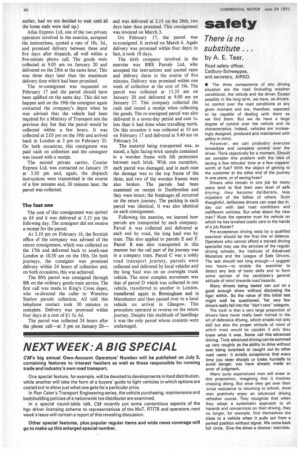There is no substitute. . •
Page 42

If you've noticed an error in this article please click here to report it so we can fix it.
by A. E. Teer,
Road safety officer. Cadbury-Schweppes, and secretary, AIRSO.
• The three components of any driving situation are the road lincluding weather conditions), the vehicle and the driver, Except possibly in the long term, we have, as drivers, no control over the road conditions at any given moment and are, therefore, expected to be capable of dealing with them as we find them. But we do have a large degree of control over the vehicle and its characteristics. Indeed, vehicles are increasingly designed, produced and maintained with safety in mind.
However, we can probably exercise immediate and complete control over the driver. Think objectively for a moment. Should we consider this problem with the idea of saving a few minutes' time or a few coppers' worth of fuel? With the object of getting to the customer at the other end of the journey in one piece, or of saving lives?
Drivers who remain in one job for many years tend to find their own level of safe driving: they become deliberate, less impatient of the follies of others. Such thoughtful, deliberate drivers can cope day in, day out with bad road conditions and indifferent vehicles. But what about the new man? Must the operator trust his vehicle on which he has lavished costly care to the hands of a job floater?
Pre-acceptance driving tests by a qualified examiner should be the first line of defence. Operators who cannot afford a trained driving specialist may use the services of the regular driving schools, the Institute of Advanced Motorists and the League of Safe Drivers. The test should last long enough—I suggest two hours—to enable the examiner to detect any lack of basic skills and to form some opinion of the candidate's general attitude of mind towards road hazards.
Many drivers being tested can put on a good enough show without disclosing the tiger within. So the value of this initial test might well be questioned. Yet very few drivers really fall into the "don't care" category.
The truth is that a very large proportion of drivers have never really been trained in the art of defensive driving, which entails not only skill but also the proper attitude of mind of which most would be capable if only they knew what it was. Some call this advanced driving. Truly advanced driving can be summed up very roughly as the ability to drive without ever being surprised or caught out by other road users: it entails acceptance that every time you steer sharply or brake hurriedly to avoid danger, you have already made an error of judgment.
Many quite experienced men will sneer at this proposition, imagining that it involves creeping along. But once they get over their initial resistance to returning to school, most men positively enjoy an advanced driving refresher course. They recognize that when they adopt a systematic approach to all hazards and concentrate on their driving, they no longer, for example, find themselves too close to a vehicle when it pulls out from a parked position without signal. We come back full circle. Give the driver a chance: train him.






















































































































